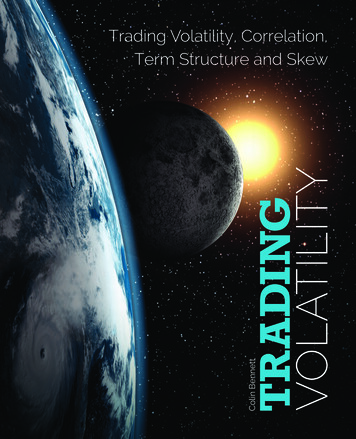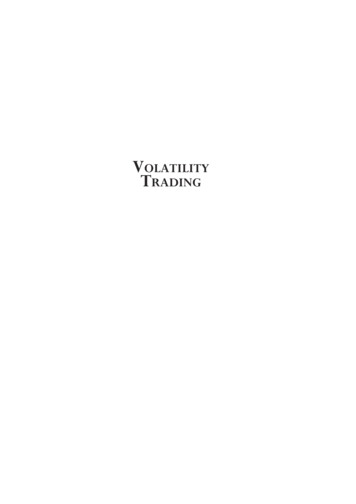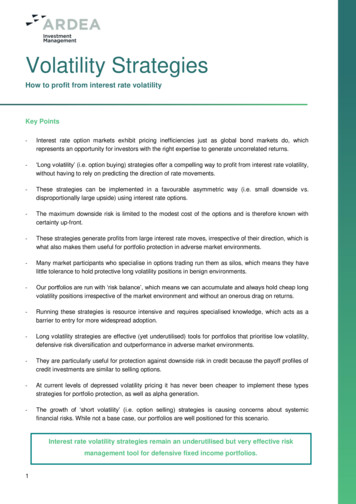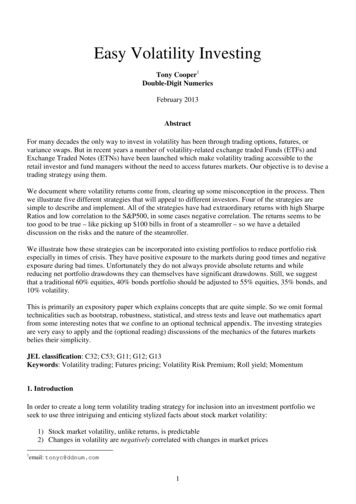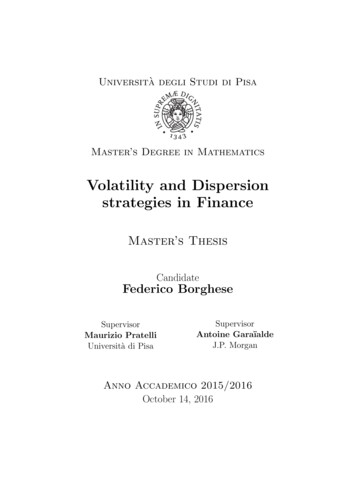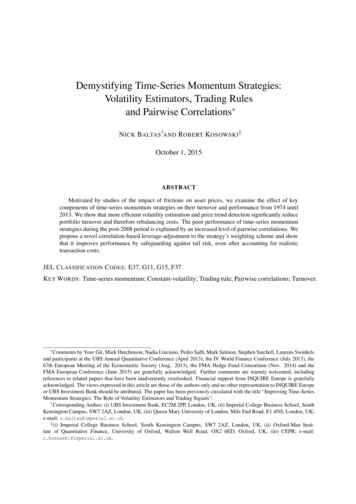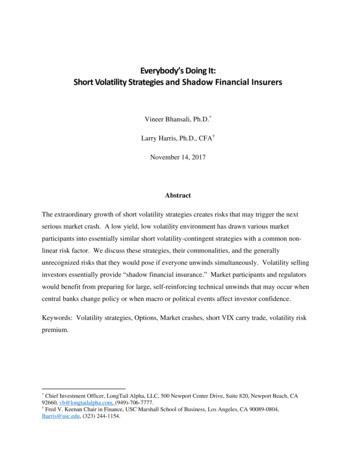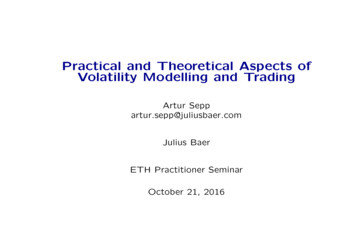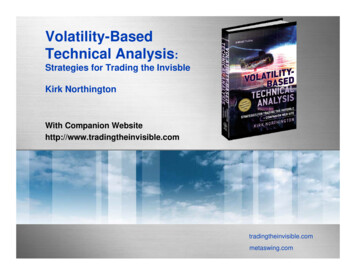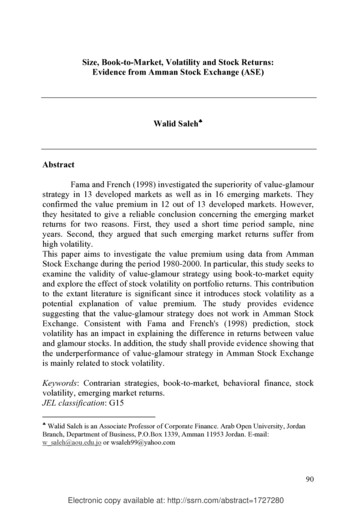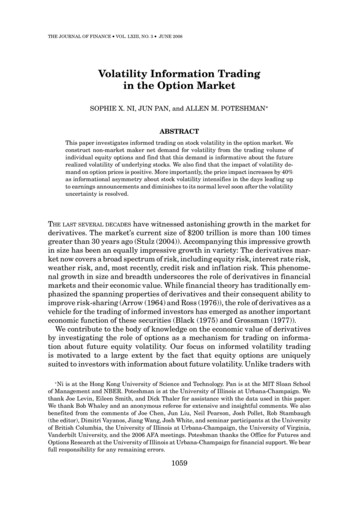
Transcription
THE JOURNAL OF FINANCE VOL. LXIII, NO. 3 JUNE 2008Volatility Information Tradingin the Option MarketSOPHIE X. NI, JUN PAN, and ALLEN M. POTESHMAN ABSTRACTThis paper investigates informed trading on stock volatility in the option market. Weconstruct non-market maker net demand for volatility from the trading volume ofindividual equity options and find that this demand is informative about the futurerealized volatility of underlying stocks. We also find that the impact of volatility demand on option prices is positive. More importantly, the price impact increases by 40%as informational asymmetry about stock volatility intensifies in the days leading upto earnings announcements and diminishes to its normal level soon after the volatilityuncertainty is resolved.THE LAST SEVERAL DECADES have witnessed astonishing growth in the market forderivatives. The market’s current size of 200 trillion is more than 100 timesgreater than 30 years ago (Stulz (2004)). Accompanying this impressive growthin size has been an equally impressive growth in variety: The derivatives market now covers a broad spectrum of risk, including equity risk, interest rate risk,weather risk, and, most recently, credit risk and inf lation risk. This phenomenal growth in size and breadth underscores the role of derivatives in financialmarkets and their economic value. While financial theory has traditionally emphasized the spanning properties of derivatives and their consequent ability toimprove risk-sharing (Arrow (1964) and Ross (1976)), the role of derivatives as avehicle for the trading of informed investors has emerged as another importanteconomic function of these securities (Black (1975) and Grossman (1977)).We contribute to the body of knowledge on the economic value of derivativesby investigating the role of options as a mechanism for trading on information about future equity volatility. Our focus on informed volatility tradingis motivated to a large extent by the fact that equity options are uniquelysuited to investors with information about future volatility. Unlike traders with Ni is at the Hong Kong University of Science and Technology. Pan is at the MIT Sloan Schoolof Management and NBER. Poteshman is at the University of Illinois at Urbana-Champaign. Wethank Joe Levin, Eileen Smith, and Dick Thaler for assistance with the data used in this paper.We thank Bob Whaley and an anonymous referee for extensive and insightful comments. We alsobenefited from the comments of Joe Chen, Jun Liu, Neil Pearson, Josh Pollet, Rob Stambaugh(the editor), Dimitri Vayanos, Jiang Wang, Josh White, and seminar participants at the Universityof British Columbia, the University of Illinois at Urbana-Champaign, the University of Virginia,Vanderbilt University, and the 2006 AFA meetings. Poteshman thanks the Office for Futures andOptions Research at the University of Illinois at Urbana-Champaign for financial support. We bearfull responsibility for any remaining errors.1059
1060The Journal of Financedirectional information about underlying stock prices who can trade in eitherthe stock or option markets, traders with volatility information can only usenonlinear securities such as options. Moreover, while the question of whethertraders use options to trade on directional information has been examined insome detail (Stephan and Whaley (1990), Amin and Lee (1997), Easley, O’Hara,and Srinivas (1998), Chan, Chung, and Fong (2002), Chakravarty, Gulen, andMayhew (2004), Cao, Chen, and Griffin (2005), and Pan and Poteshman (2006)),the analogous question about volatility information trading has not been systematically addressed in the literature.1 Since volatility plays such a centralrole in both the pricing of options and the reasons for trading options, a betterunderstanding of volatility information trading is clearly important.Our empirical investigation takes advantage of a unique data set from theChicago Board Options Exchange (CBOE) that records purchases and sales ofput and call options by non-market makers over the 1990 to 2001 period. Foreach underlying stock, we construct daily non-market maker net demand forvolatility. Motivated by theoretical models of private information trading, particularly those of Kyle (1985) and Back’s (1993) extension of it to a setting thatinclude options, we pursue two strands of empirical investigation to examinethe presence of volatility information trading in the option market. First, weinvestigate the extent to which the volatility demand extracted from the optionmarket predicts the future volatility realized by underlying stocks. Second, weexamine the price impact of volatility demand, focusing especially on the timevariation of the price impact leading up to earnings announcements when thelevel of informational asymmetry is high. Both of these strands yield evidencein support of volatility information trading in the option market.Our first main finding is that option market demand for volatility predictsthe future realized volatility of underlying stocks even after controlling foroption implied volatility and a number of other variables. The predictabilitylasts at least 1 week into the future and is robust to different measures ofrealized volatility and controls for directional information in the option volume.A natural interpretation of the evidence that option volume is informative aboutfuture volatility is that investors trade on volatility information in the optionmarket and the information is subsequently ref lected in the underlying stocks.1The mass media, however, often attributes option market activity to volatility trading. Forexample, on October 5, 2006, the Wall Street Journal reported heavy trading of McDonald’s options (Hodi (2006f)): “Nearly 100,000 calls and 94,000 put options changed hands, many of themsimultaneously, in a position called a straddle. A straddle involves buying a put and a call at thesame strike price, and profits from a large move in the stock in either direction.” More interestingly, a large fraction of these straddles targeted the November contracts. The catalyst for thetrading? “The Company is due to report September sales on Oct. 12. McDonald’s tends to previewquarterly earnings during such reports. The company is expected to report detailed earnings forthe third-quarter later this month” (Hadi (2006f)). For further examples, see Hadi (2006a–2006e).Lakonishok, Lee, Pearson, and Poteshman (2007) provide evidence that only a small percentage ofthe option trading of customers of a discount brokerge house could be part of volatility trades suchas straddles or strangles. Pearson, Poteshman, and White (2007) show that option trading impactsthe volatility of underlying stocks.
Volatility Information Trading in the Option Market1061This interpretation is corroborated by two additional results. First, we findthat the non-market maker net demand for volatility constructed from open option volume (trades in which non-market makers open brand new option positions) has stronger predictability in both magnitude and statistical significancethan that constructed from close option volume (trades in which non-marketmakers close existing option positions). While both open and close trades can beinformationally motivated, the informational content of close trades is expectedto be lower because traders can only use information to close positions if theyhappen to have appropriate positions open at the time they become informed.The stronger predictability of the net demand constructed from open volumeis therefore consistent with the predictability we identify having its economicsource in volatility information trading in the option market.2 Second, we findthat the net demand for volatility constructed from option volume that couldhave been part of straddle trades is a stronger predictor of future volatilitythan net demand for volatility constructed from option volume that could nothave been part of straddle trades. Since straddles are the leading strategy fortrading on volatility, the stronger predictability of the volume with the higherconcentration of straddle trading is also consistent with the predictability weidentify originating from informed volatility trading in the option market.Our second main finding is that volatility demand has a positive and timevarying price impact that increases on days leading up to earnings announcements. In standard information trading models such as that in Kyle (1985),the presence of informational asymmetry induces the market maker to adjustprice in response to demand, resulting in a positive relation between equilibrium price and demand. Our empirical analysis shows that the net demand forvolatility indeed positively impacts option prices.Although the finding of a positive price impact confirms a prediction of thehypothesis that option investors trade on private volatility information, it couldalso be produced by demand pressure that is unrelated to informational asymmetry. We offer two additional results to assess whether the positive price impact is produced by demand pressure alone. In both analyses, we take advantage of the fact that unlike pure demand pressure, the price impact caused byinformational asymmetry depends in an important way on the level of informational asymmetry. We first employ earnings announcements to exploit timevariation in informational asymmetry. Prescheduled earnings announcementsare exogenous information events. Thus, in the period leading up to earningsannouncements days (EADs), option market makers face increasing informational asymmetry. While there will be informational asymmetry about both thedirectional move and the volatility of the underlying stock price at the EAD,the asymmetry about volatility information is likely to be of more concern to2An alternative explanation for this result is that closing trades are more likely to be in-themoney or out-of-the-money, both of which are less sensitive to volatility. To check whether this is thecase, we compared the relative predictability within each category of moneyness and found that thepredictability from opening option transactions dominates that from closing option transactionsregardless of the moneyness category.
1062The Journal of Financeoption market makers.3 Our results show that the price impact per unit of nonmarket maker net demand for volatility increases as informational asymmetryincreases in the week leading up to EADs. By the day before EADs, the priceimpact per unit of volatility demand increases to 40% above its normal level.Following EADs, the additional price impact diminishes and becomes statistically insignificant. Since the time variation in the price impact mirrors thetime variation in informational asymmetry, this evidence is consistent withmarket makers protecting themselves from option market trades motivated byvolatility information.4To further address the alternative hypothesis of demand pressure, we makeuse of the fact that volume that opens and closes option positions is associatedwith different levels of informational asymmetry. For example, in our predictive analysis, we find that the non-market maker net demand for volatilityconstructed from open option volume has stronger predictability than thatfrom close option volume, indicating a higher informational content for theopen volume. Similarly, Pan and Poteshman (2006) show that open volumecontains more information than close volume about the future direction of underlying stock prices. If the market makers possess any ability to distinguishopen trades from close trades, they will react more to open volume because ofits greater informational content.5 This additional price impact is unrelatedto pure demand pressure and can be attributed to informational asymmetry. Our analysis indicates that open volume does indeed have a greater priceimpact.Our paper relates to several strands of the empirical option literature. First,our predictive analysis is related to the literature that examines the informational content of option-implied volatility for future realized volatility.6 Acommon finding in these papers is that the implied volatility subsumes otherpublicly available information, including the past-realized volatility (e.g., seeChristensen and Prabhala (1998)). The reason that implied volatility providesbetter predictions may be that information about future volatility is impounded3The market makers can delta-hedge (with the underlying stock) the risk associated with thedirectional move, but collectively they must bear the volatility risk. Moreover, informed traderswith directional information can trade in either the option or the stock market, while traders withvolatility information can only trade in the option market.4It is also interesting to note that the predictive power of net volatility demand approximatelydoubles on the day before EADs compared to the average level of 1-day ahead predictability. Thisresult is consistent with the hypothesis that volatility demand contains more information beforeEADs.5Although the market makers do not directly observe in real time whether trades open or closeoption positions, at the end of the day they can infer the breakdown of open versus close tradesduring the day from changes in open interest. It seems likely that they would develop some realtime ability to assess the probability that trades coming into the market are opening or closingpositions.6See, for example, Latane and Rendleman (1976), Canina and Figlewski (1993), Christensen andPrabhala (1998), Day and Lewis (1992), Jorion (1995), Lamoureux and Lastrapes (1993), Poteshman (2000), Ederington and Guan (2002), and Chernov (2002). In a similar vein, Ederington andLee (1996) investigate the impact of news on option implied volatility.
Volatility Information Trading in the Option Market1063into option prices through the trading process. By using quantity information inaddition to price information, our predictive an
option market makers.3 Our results show that the price impact per unit of non-market maker net demand for volatility increases as informational asymmetry increases in the week leading up to EADs. By the day before EADs, the price impact per unit of volatility demand increases to
